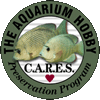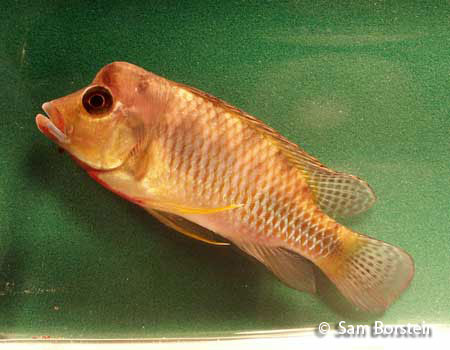Ctenochromis polli
(Thys Van Den Audenaerde, 1964)
Synonyms: Haplochromis polli



Above: A male Ctenochromis polli. Photo by Sam Borstein.
Etymology:
Genus- Cteno= comb (Greek), chromis= a fish, perhaps a perch (Greek).
Species- polli= named after Max Poll.
Intro:
Ctenochromis polli is a very interesting West African cichlid. This is one of the first West African Haplochromines to be brought into the United States, but nowdays, it is found in sporadic numbers. This rheophilic cichlid is aggressive, but small, and can be housed with many other types of fish.
Distribution:
Ctenochromis polli is found in the lower Congo River.
Size, Maturity, and Sexual Dimorphism:
Size: Males- 4 inches, Females- 3.5 inches
Maturity: 1 inch
Sexual Dimorphism: Males are larger than females and show a red throat when territorial or breeding. Older males also may develop a nuchal hump.
Care:
This fish can pack a punch for its size. Because it is relatively small, it can be housed in small tanks. A breeder group can easily be kept in a 20, or a 40 breeder with either mbuna or Malawi Haps. This fish likes water that is pretty hard and a pH at about 7-7.4.
Diet:
This fish is not picky, and will gladly take any food. In the wild they eat insect larvae.
Breeding:
This fish was pretty easy to breed. I stress keeping the females in good condition and managing aggression. If you do that, they should breed readily. Before spawning, the males throat gets a very intense red and black color. Breeding is like that of Victorian Haplochromines.
These fish were great holders, even when young, at about 1 inch. They held for about 16 days. The fry were pretty small and my largest spawn was 24, from a 3 inch female. Fry are easy to raise on baby brine shrimp and grow fast. At 3/4 of an inch, you can see them develop their color and the red throat of males.
Conclusion:
Ctenochromis polli are not the prettiest fish, but they are active and a joy to have. This is possibly my favorite West African cichlid. You will not find these at pet shops, but a local breeder may have them. Keep an eye out for these guys.
References:
- IUCN. IUCN Red List of Threatened Species. <http://www.iucnredlist.org>.
- Lamboj, A. (2004). The Cichlid Fishes of Western Africa. Bergit Schmettkamp Verlag, Bornheim, Germany, 255 pp.
